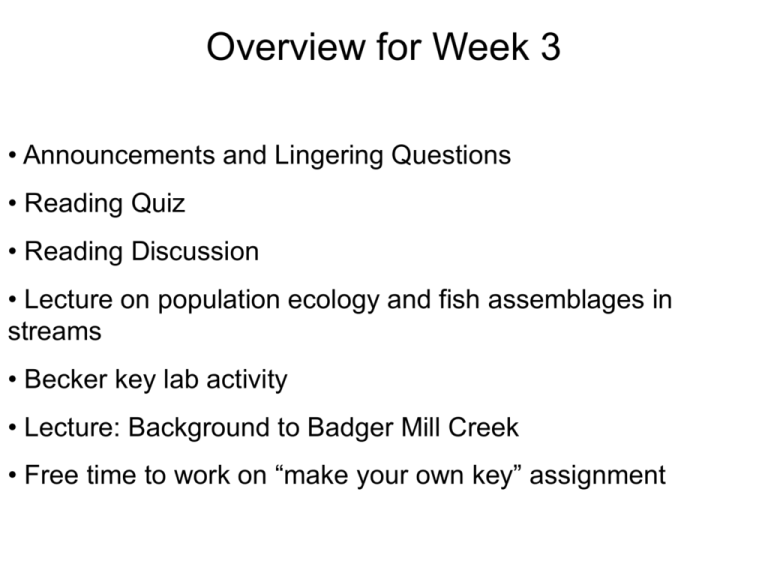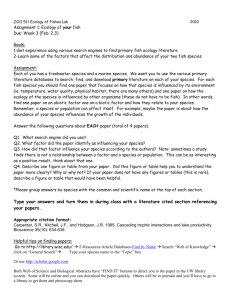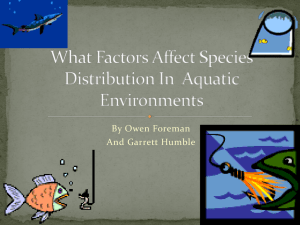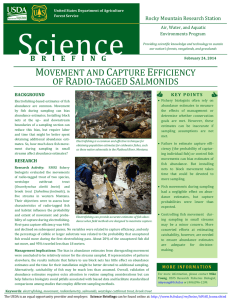Week 3 Population Ecology WEB VERSION
advertisement

Overview for Week 3 • Announcements and Lingering Questions • Reading Quiz • Reading Discussion • Lecture on population ecology and fish assemblages in streams • Becker key lab activity • Lecture: Background to Badger Mill Creek • Free time to work on “make your own key” assignment Announcements and Lingering Questions • Field trip next week barring massive conspiracy • Meet at 1pm, arrive back at 5pm • Wader sizes • You need: weather appropriate layers (hats, gloves, etc.), a pencil, positive attitude • Questions from week two: • Brown, brook, and rainbow trout • Gape limitation • Sculpin fin typo • Not responsible for distributions, only major trends Announcements and Lingering Questions • Assignments 1 and 2 due next week! Reading Quiz 1. Name one of the authors of this paper. (1pt) 2. If the population of piscivores increases in a lake, what happens to the density of phytoplankton? (2pts) 3. How does “time lag” apply to trophic cascades? (1pt) Reading Discussion Vertebrate Planktivore Invertebrate Planktivore Large zooplankton Nutrients (P and N) Lake Productivity Nutrients (mg P/L) How do you interpret this figure? What piece of information does it convey? How pervasive are trophic cascades in reality? Can you think of other examples of trophic cascades? Any examples of systems where they do not exist? What is a model? Population Ecology and Habitat Use (Autecology) What is Population Ecology? • Ecology is the study of the distribution and abundance of living organisms and how the distribution and abundance are affected by interactions between the organisms and their environment (Krebs). • Population represents one “level” on which to approach ecology – Other levels??? What is a Population? • “A population is a group of fish of the same species that are alive in a defined area at a given time” (Wootton 1990) – Area can be arbitrary, physical, or genetic • Give examples on chalkboard – “Stock” = population subject to fisheries management Population Abundance • On rare occasions, abundance can be measured directly – Small enclosed systems – Migration http://www.acoustics.org/press/149t h/holmes.htm Population Abundance • Usually, abundance is assessed from samples – Eggs estimated with quadrats – Pelagic larvae sampled with modified plankton nets – Juvenile and adult fish with nets, traps, hook and line, or electrofishing Mark/Recapture n2 n1 m Sample 1 = 10 Sample 2 = 9 with 2 marked N n1/N=m/n2 Or N=n1n2/m Population = ??? Population Density Density = fish/unit area Abundance = # fish in population CPUE can estimate density CPUA measures density directly Population Change Stocking Natality Immigration DENSITY Mortality Angling There are a number of ways to measure growth rate and mortality. Emigration Catch per Unit Effort If two samples are taken with the same fishing effort over a short time period, mortality, stocking, and recruitment are negligible Catch per Unit Effort n2 n1 Sample 1 = 20 Probability of capture = n1/N Sample 2 = 10 Probability of capture = n2/(N-n1) Assume probability of capture is constant Then N = n12/(n1-n2) Patterns of Mortality • Eggs and larvae suffer the largest losses HATCH Egg Larva Viable & Competent Not Fertile Starvation Inviable Eaten Eaten Other 2 cohorts each produce 10,000,000 eggs 90.5% survivorship/day yields 24,787 survivors at 60 days 95.1% survivorship/day yields 497,871 survivors at 60 days Recruit! Density Dependence 45 Death Rate Birth Rate 40 35 30 Rate of Change (per capita) 25 20 15 10 5 0 0 5 10 Population Density 15 20 Density Dependence 60 Density Independent Beverton-Holt Ricker 50 40 Recruitment 30 20 10 0 0 5 10 Stock (Parental Cohort) 15 20 Fish Populations in Wisconsin • Populations of fish are distributed based primarily on: – Type and amount of food available – Temperature – Oxygen demand – Flow velocity – Tolerance of pollution Food and Thermal Niches 4 3.5 Largemouth bass 3 2.5 Prey Weight (Relative) 2 1.5 1 Green Sunfish 0.5 Bluegill 0 25 26 27 28 29 30 31 Temperature (Celsius) 32 33 34 Distribution in Lakes: Temperature 20-30 C 4-20 C 4C Distribution in Lakes: Temperature • Habitat separated and competition reduced by stratification – Bass and Bluegill (eurytherms) in the epilimnion – Pike, Perch, and walley (mesotherms) in the metalimnion – Lake Trout (stenotherms) in the hypolimnion • Competition in winter more intense Movement • Fishes may move about the water column or around various depths for – Foraging: shallow water cooler at night; plankton moves about at night – Spawning: nest sites often in shallows Oxygen Demand • Eutrophic lakes can have anoxic hypolimnions in the summer • Primarily affects coldwater species (i.e. trout) Lotic Systems Here be Floodwaters Flowing Water Watershed Boundry Distribution in Rivers • Systems zone longitudinally – Chalk Talk Fish Distribution in Rivers • Headwaters are colder, faster, and have limited primary producers (Trout, Sculpin) • Transitional zones variable (cold/cool/warm) • Deposition zones are warm, slow, turbid (from sediment load) and polluted (from proximity to agriculture and urban areas) (Carp, Centrachids) 100 90 80 Fish Abundance 70 60 Sculpin 50 Dace 40 30 20 10 0 1 2 3 4 5 6 7 8 9 Station (1=downstream) From Baltz et al. 1982 10 11 12 Diversity Within A Reach • Riffles (scuplins, stonerollers, darters – smaller fish) – – – – High flow velocity Well oxygenated Rocky substrate Generally shallow • Eddies/pools (trout, larger fish) – – – – Low flow velocity Also well oxygenated More cover Generally deep Lab: Identifying Fish • Dichotomous keys – Will always present you with two choices, e.g.: • Body noticeably covered with scales: Go to 2 • Scales not covering body or too small to be seen: Go to 12 – Follow the choices until you have reached a species! – Becker’s “Fishes of Wisconsin” tome provides our class with our keys Things to keep in mind • Some choices are obvious (i.e. jaws vs. jawless). • Many others require careful scrutiny: – Lateral line has 45-48 scales (Library Carp, Nerdus poindexterii) – Lateral line has 50-56 scales (Northern Shiteater, Carpus stinkostomus) • Finding the lateral line, counting scales, identifying mouth parts…struggling through the keys now will save you strife later Secondary Keys • www.wiscfish.org – Non-dichotomous: harder to narrow down to species, easier to get to a few choices – Actual photos, detailed attribute descriptions help identify species – Requires a computer, not good for field IDs • Google.com – There’s bound to be something there Badger Mill Creek Field Trip Goals - Illustrate aspects of fish ecology in a Wisconsin trout stream - Collect fish and stream habitat data to use in research paper - Demonstrate various field methods for fish collection - Experience the field portion of research Quick Question: How many people have waders? What’s Ecology -is the study of the distribution and abundance of living organisms and how the distribution and abundance are affected by interactions between the organisms and their environment (Krebs). Metrics! Fish • • • • • • • Length Weight Species Number Sampling Effort Diet Method of Sampling Habitat • • • • • • • • • Reach length Width Depths Velocity Substrate Canopy cover Land width Buffer width Undercut Two teams everyone works on both teams! How does habitat influence fish community? Defining Geomorphic Stream Units Undercut Bank Riffle Pool Run Goal is to sample at least 6 different units! Notice how they are positioned ANODE (business end) Use the current(s) to your advantage!! Lead fish right to your netters Moving Block Nets 2 people Electrofishing 5 people Fish can be released down stream of electrofishing crew Workup Station 3 people HOW TO SET UP Stream habitat measurements Flagging transects 2 people Flow Velocity 1 person Measure thalweg, depth, width 4 people Data Recorders- MOST IMPORTANT!!! 2 people IBI= index of biotic integrity.




